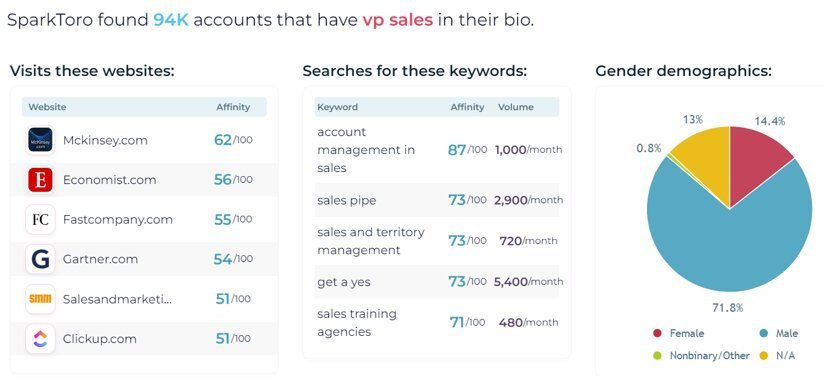After reflecting on more than two decades of involvement in search engine optimization (SEO), I recognize the necessity of continually updating actionable insights in this age of rapid change.
Although change has always been a constant, the accelerated development of artificial intelligence (AI) is within SEO a challenge to keep up. The landscape of Search is characterized by uncertainties, and not all advice stands the test of time.
Our to-do lists seem to constantly exceed our available resources and require precision in how we allocate them.
So, what are the key strategic SEO insights and practical tips to prioritize under 2024 and forwards?
1. Conduct audience research alongside keyword research:
Traditional keyword research tools have been a staple since 2002, but the advent of tools like SparkToro, with a focus on audience research, marks a significant shift. Unlike conventional keyword research, SparkToro V2 provides insights not only into search volumes but also into the demographics, interests and behaviors of searchers. This step beyond optimizing for a broad spectrum of users to understanding specific audience segments is critical in the current SEO landscape.


2. Analyze the purpose of the search query:
Understanding user intent behind search queries is fundamental to delivering relevant results. Google's advances in language modeling over the years enable a better grasp of user intent and distinguish between exploration and evaluation phases of the user journey. This nuanced understanding enables tailored content strategies.
3. Create custom content:
Segmenting questions into exploration and evaluation categories facilitates the creation of relevant content for distinct user segments. By tailoring content to specific user personas and their respective stages in the buying journey, SEO professionals can increase engagement and conversions.
Expand on content creation:
In today's content-saturated digital environment, the emphasis is not only on creating content, but also on creating content that resonates deeply with the target audience. It's not just about understanding demographics and interests, but also delving into psychographics and emotional triggers. Incorporating story elements, interactive formats, and multimedia experiences can increase content engagement and foster stronger connections with users.
4. Emphasize quality content:
The importance of quality content has been underlined by Google's algorithms, especially with updates like Panda. While technological advancements enable faster content creation, investing in high-quality, authoritative content is critical to long-term SEO success.

Addressing Content Quality:
Beyond surface-level considerations, such as grammar and formatting, quality content encompasses depth, relevance and value. Conducting thorough research, offering unique perspectives, and providing actionable insights are key elements of high-quality content. Furthermore, promoting expertise, authority and credibility (EAT) through content creation helps build credibility and establish thought leadership within respective niches.
5. Evaluate the usability of the page:
Considering factors such as mobile-friendliness and page load speed is critical to improving the user experience, a determining factor for search rankings.
Improve user experience:
In addition to technical optimizations, user-centered design principles should guide website development and optimization efforts. Streamlining navigation, optimizing for accessibility and prioritizing content readability contribute to a seamless user experience. By performing usability tests and gathering user feedback, pain points can be identified and iterative improvements can be made to improve overall usability.
6. Understanding context and settings:
It is important to understand how user context and search preferences affect search results. Personalization plays an important role in delivering relevant content to users, which requires an understanding of how search preferences affect search results.
Take advantage of personalization:
As search engines increasingly prioritize personalized experiences, SEO professionals must adapt their strategies to accommodate user preferences and behaviors. Tailoring content recommendations, leveraging location-based targeting, and optimizing for voice search are strategies for taking advantage of personalization trends. In addition, optimizing metadata and structured data markup can improve search visibility and improve relevance in personalized search results.
7. Prepare for evolving search trends:
Anticipating changes in search dynamics, such as the potential impact of Search Generative Experiences (SGE), is critical. While the full implications of such changes may not yet be clear, it is wise to stay informed and adopt flexible strategies.
Address new trends:
New technologies, such as artificial intelligence and voice search, continue to reshape the search landscape. To keep abreast of industry developments, ömonitor algorithm updates and get involved in continuous learning are important methods for navigating new search trends. Furthermore, fostering adaptability and agility in SEO strategies enables proactive responses to new challenges and opportunities.
Conclusion:
When navigating the dynamic landscape of SEO, using frameworks like the “70% Solution,” which emphasize making decisions with incomplete information, can be invaluable. Despite uncertainties, maintaining a proactive approach and focus on delivering value to users remain core principles of SEO strategy.
As the saying goes, “Keep calm and carry on” amidst the ever-changing SEO landscape. By embracing change, prioritizing user-centricity, and fostering innovation, SEO professionals can thrive in a time of constant change.











